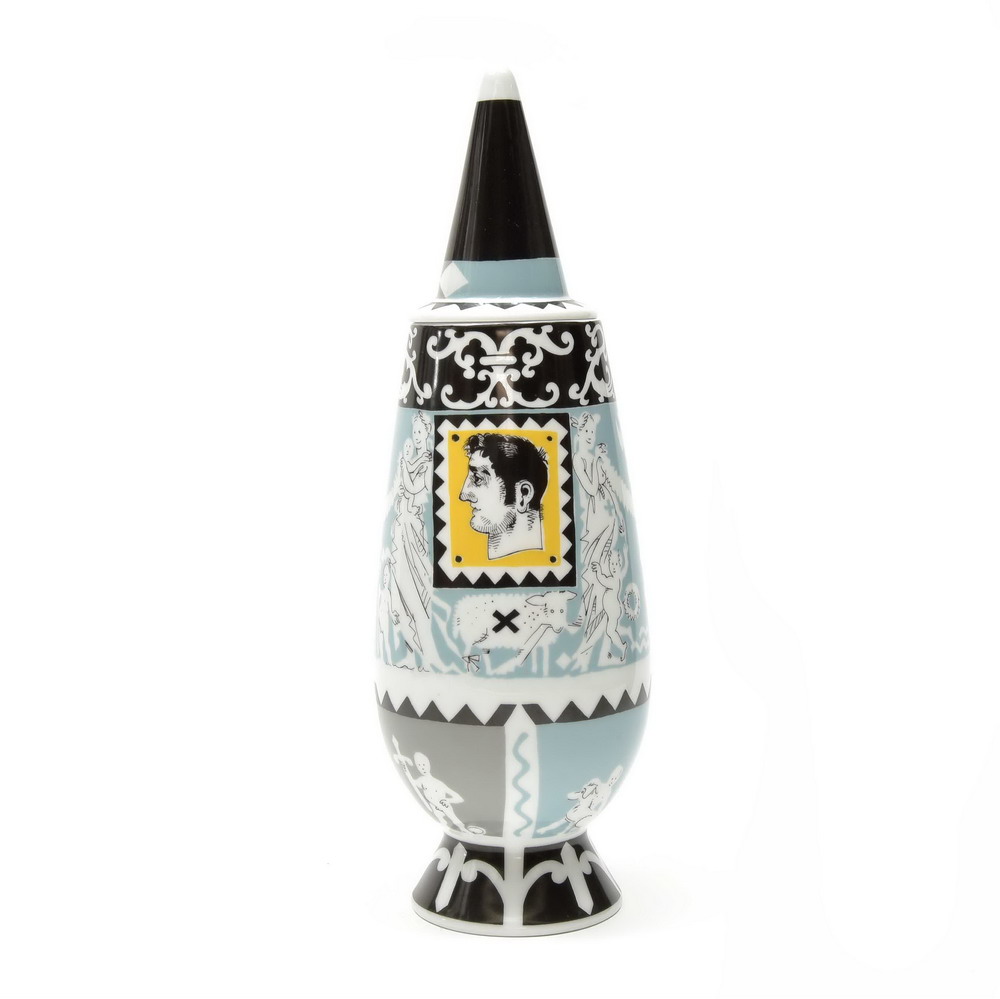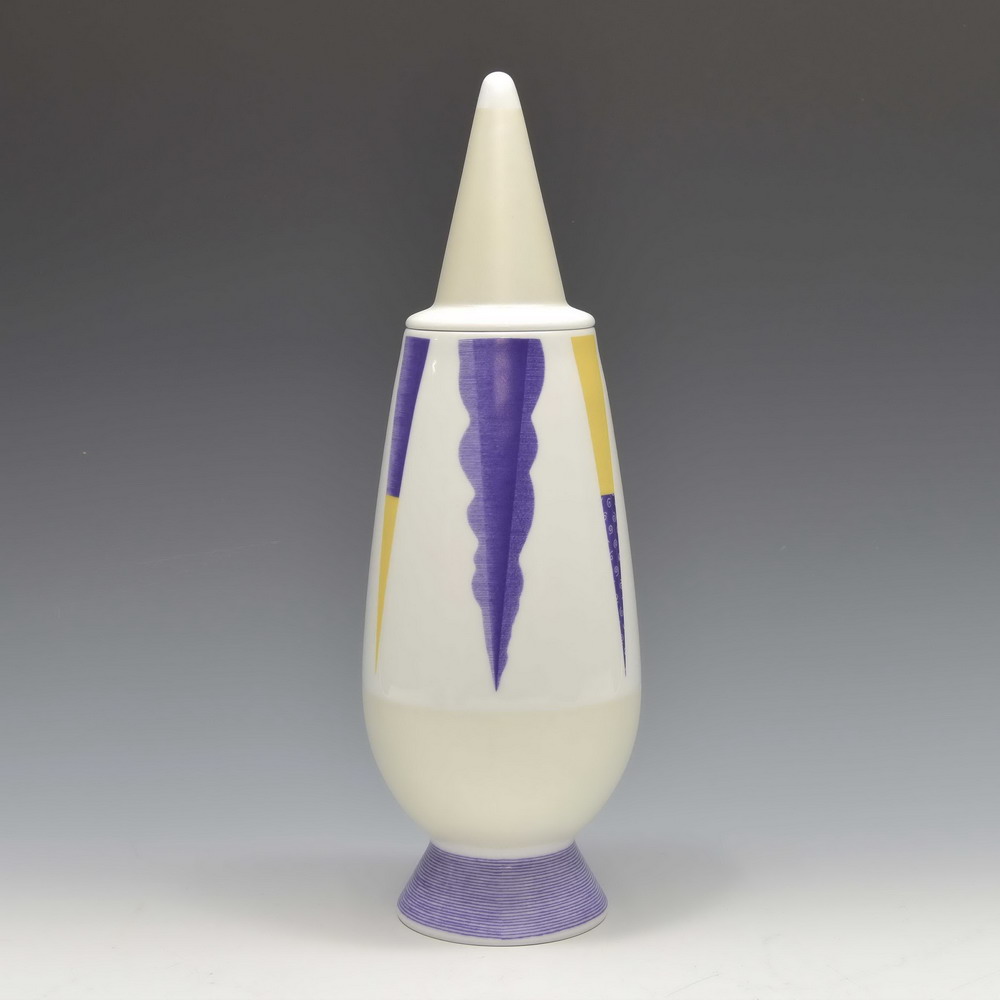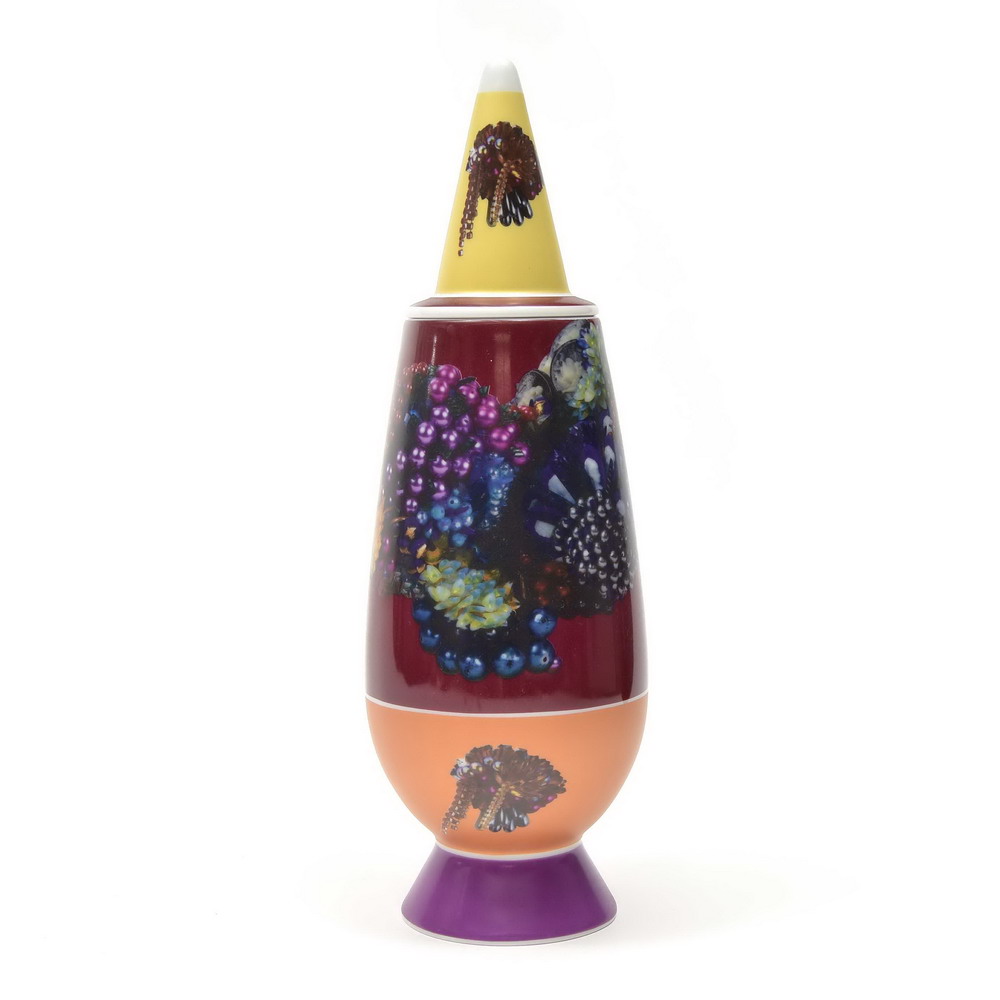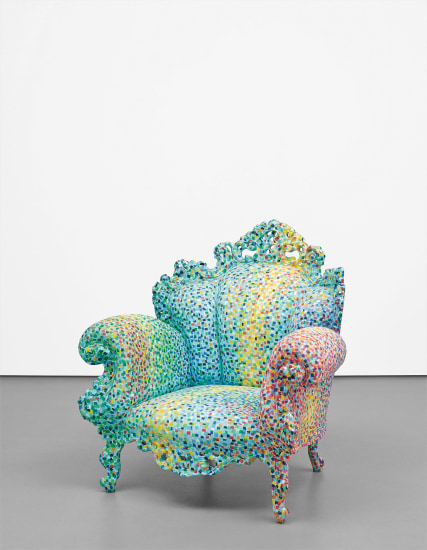Alessandro Mendini'Poltrona di Proust' armchair, designed 1978, executed 1983
Painted wood, painted fabric upholstery.
109 x 92 x 92 cm
Hand-painted by Prospero Rasulo. Together with a certificate of authenticity from the Alessandro Mendini Archive.
FootnotesProvenance
Heal's, Tottenham Court Road, London
Acquired from the above by the present owner, 1984
Exhibited
Mobili Italiani Moderni, Robot Sentimentale, Rome, May 1983
Heal's, London, 1984
Literature
Rosa Maria Rinaldi, 'Memphis e Alchimia', Domus, no. 646, January 1984, p. 55
Andrea Branzi, The Hot House: Italian New Wave Design, London, 1984, pp. 123, 126
Albrecht Bangert, Italian Furniture Design: Ideas Styles Movements, Munich, 1988, pp. 63, 65, 116
Peter Weiss, Alessandro Mendini: Objetos, proyectos, construcciones, Milan, 2001, pp. 100-01, 119
Glenn Adamson and Jane Pavitt, eds., Style and Subversion, 1970-1990, exh. cat., Victoria and Albert Museum, London, 2011, p. 41
Cindi Strauss, Germano Celant, et al., Italian Radical Design: The Dennis Freedman Collection, exh. cat., Museum of Fine Arts Houston, New Haven, 2020, pp. 75, 121
Bonhams wishes to thank the Alessandro Mendini Archive for their assistance with the cataloguing of the present lot.
Bomba Estetica
The Proust Chair defines post-modernism in much the same way Gerrit Rietveld's Red Blue chair defined modernism.
Rietveld took the rules of the De Stijl group as his parameters. He worked within a palette of primary colours (plus black, grey and white) and used only straight lines, to produce an economical design that served as the blueprint for modernism. Marcel Breuer's design for apprentice pieces to be made in the Bauhaus workshops is clearly derivative, his tubular steel furniture less economical, in design thus cost, whilst Ludwig Mies van der Rohe's addition of cushions to structure lacks the material integrity of Rietveld's chair. More was less so the Red Blue chair remains the Platonic ideal of the modernist chair.
Alessandro Mendini's Proust Chair similarly defined post-modern. His painting of a kitsch monster-piece with a pointillist detail of a work by Paul Signac signalled a relativism between high and low culture. Rather than being its arbiter, the post-modern architect should accommodate the taste, even the bad taste, of the client. A found object, the chair also signalled the architect's wider obligation to accommodate the city as ready-made. It is a hotch-potch of different styles, mosaic colours and people which, rather than being bulldozed and built anew along rational lines as Le Corbusier advocated, should be added to it in accordance with its citizen's physical needs and emotional desires.
The Proust is a big chair, as dominant in even the grandest interior as in the history of architecture. The first five or six were jointly painted by Pierantonio Volpini and Prospero Rasulo and mostly sold to museums. New York gallerist Rick Kaufman called the Proust "the best chair I had ever seen" and began retailing it to the public. Others followed.
To meet demand, Franco Migliaccio was employed to paint the next batch of chairs. His early brushwork followed Paul Signac's pattern before morphing into his own style. Jesus Moctezuma took over in 1981 using a brighter palette. Claudia Mendini followed in the mid-80s whilst in a nod to the chair's monumental status, two were painted to resemble bronze.
Mendini estimated upwards of thirty Proust chairs were produced under the auspices of Alchimia but the one in this sale is unusual in two ways. Produced in 1983, its decorator has been identified by Atelier Mendini as Prospero Rasulo. In Mendini's "Story of the Proust Chair", no mention is made of Rasulo decorating chairs beyond his initial collaboration with Volpini so this late reprise is anomalous. Second, the chair has a cushion and, although Mendini documented variations to the seat over the years, he made no mention of a cushioned version.
After researching this chair, Beatrice Felis, together with Fulvia and Elisa Mendini, have determined that it was "made for the performance Robot Sentimentale conceived by Alessandro Mendini with Alchimia and performed at the MIM showroom in Rome in 1983". Beatrice Felis adds that the hitherto undocumented cushion "rewrites" the story of the Proust Chair.
The Proust has a huge architectural and aesthetic charge; Alessandro Mendini described it to me as a "bomba estetica." That bomb exploded late modernism and in the void was built the post-modern world we live in today. Moreover, the story of the Proust Chair, like the movement the chair has come to symbolise, continues to be told and, in this case, retold.
Designer and author, Nick Wright is the writer of Cut and Shut, The History of Creative Salvage.
Alessandro Mendini'Poltrona di Proust' armchair, designed 1978, executed 1983
Painted wood, painted fabric upholstery.
109 x 92 x 92 cm
Hand-painted by Prospero Rasulo. Together with a certificate of authenticity from the Alessandro Mendini Archive.
FootnotesProvenance
Heal's, Tottenham Court Road, London
Acquired from the above by the present owner, 1984
Exhibited
Mobili Italiani Moderni, Robot Sentimentale, Rome, May 1983
Heal's, London, 1984
Literature
Rosa Maria Rinaldi, 'Memphis e Alchimia', Domus, no. 646, January 1984, p. 55
Andrea Branzi, The Hot House: Italian New Wave Design, London, 1984, pp. 123, 126
Albrecht Bangert, Italian Furniture Design: Ideas Styles Movements, Munich, 1988, pp. 63, 65, 116
Peter Weiss, Alessandro Mendini: Objetos, proyectos, construcciones, Milan, 2001, pp. 100-01, 119
Glenn Adamson and Jane Pavitt, eds., Style and Subversion, 1970-1990, exh. cat., Victoria and Albert Museum, London, 2011, p. 41
Cindi Strauss, Germano Celant, et al., Italian Radical Design: The Dennis Freedman Collection, exh. cat., Museum of Fine Arts Houston, New Haven, 2020, pp. 75, 121
Bonhams wishes to thank the Alessandro Mendini Archive for their assistance with the cataloguing of the present lot.
Bomba Estetica
The Proust Chair defines post-modernism in much the same way Gerrit Rietveld's Red Blue chair defined modernism.
Rietveld took the rules of the De Stijl group as his parameters. He worked within a palette of primary colours (plus black, grey and white) and used only straight lines, to produce an economical design that served as the blueprint for modernism. Marcel Breuer's design for apprentice pieces to be made in the Bauhaus workshops is clearly derivative, his tubular steel furniture less economical, in design thus cost, whilst Ludwig Mies van der Rohe's addition of cushions to structure lacks the material integrity of Rietveld's chair. More was less so the Red Blue chair remains the Platonic ideal of the modernist chair.
Alessandro Mendini's Proust Chair similarly defined post-modern. His painting of a kitsch monster-piece with a pointillist detail of a work by Paul Signac signalled a relativism between high and low culture. Rather than being its arbiter, the post-modern architect should accommodate the taste, even the bad taste, of the client. A found object, the chair also signalled the architect's wider obligation to accommodate the city as ready-made. It is a hotch-potch of different styles, mosaic colours and people which, rather than being bulldozed and built anew along rational lines as Le Corbusier advocated, should be added to it in accordance with its citizen's physical needs and emotional desires.
The Proust is a big chair, as dominant in even the grandest interior as in the history of architecture. The first five or six were jointly painted by Pierantonio Volpini and Prospero Rasulo and mostly sold to museums. New York gallerist Rick Kaufman called the Proust "the best chair I had ever seen" and began retailing it to the public. Others followed.
To meet demand, Franco Migliaccio was employed to paint the next batch of chairs. His early brushwork followed Paul Signac's pattern before morphing into his own style. Jesus Moctezuma took over in 1981 using a brighter palette. Claudia Mendini followed in the mid-80s whilst in a nod to the chair's monumental status, two were painted to resemble bronze.
Mendini estimated upwards of thirty Proust chairs were produced under the auspices of Alchimia but the one in this sale is unusual in two ways. Produced in 1983, its decorator has been identified by Atelier Mendini as Prospero Rasulo. In Mendini's "Story of the Proust Chair", no mention is made of Rasulo decorating chairs beyond his initial collaboration with Volpini so this late reprise is anomalous. Second, the chair has a cushion and, although Mendini documented variations to the seat over the years, he made no mention of a cushioned version.
After researching this chair, Beatrice Felis, together with Fulvia and Elisa Mendini, have determined that it was "made for the performance Robot Sentimentale conceived by Alessandro Mendini with Alchimia and performed at the MIM showroom in Rome in 1983". Beatrice Felis adds that the hitherto undocumented cushion "rewrites" the story of the Proust Chair.
The Proust has a huge architectural and aesthetic charge; Alessandro Mendini described it to me as a "bomba estetica." That bomb exploded late modernism and in the void was built the post-modern world we live in today. Moreover, the story of the Proust Chair, like the movement the chair has come to symbolise, continues to be told and, in this case, retold.
Designer and author, Nick Wright is the writer of Cut and Shut, The History of Creative Salvage.











Testen Sie LotSearch und seine Premium-Features 7 Tage - ohne Kosten!
Lassen Sie sich automatisch über neue Objekte in kommenden Auktionen benachrichtigen.
Suchauftrag anlegen